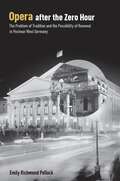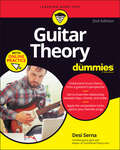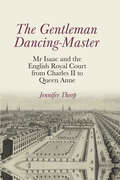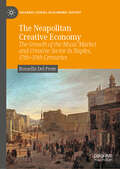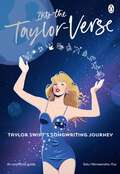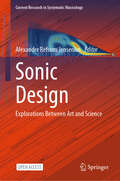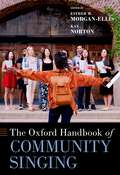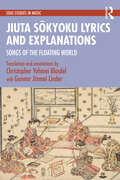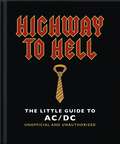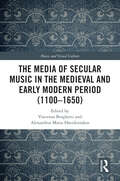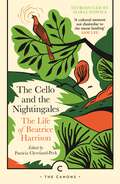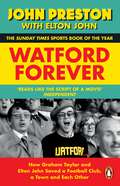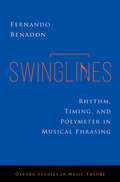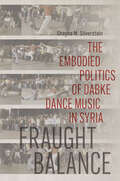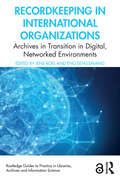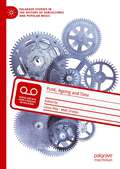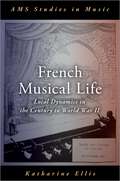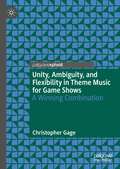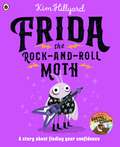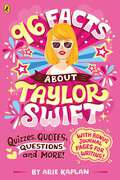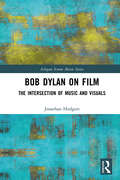- Table View
- List View
Opera After the Zero Hour: The Problem of Tradition and the Possibility of Renewal in Postwar West Germany
by Emily Richmond PollockOpera After the Zero Hour: The Problem of Tradition and the Possibility of Renewal in Postwar West Germany presents opera as a site for the renegotiation of tradition in a politically fraught era of rebuilding. Though the "Zero Hour" put a rhetorical caesura between National Socialism and postwar West Germany, the postwar era was characterized by significant cultural continuity with the past. With nearly all of the major opera houses destroyed and a complex relationship to the competing ethics of modernism and restoration, opera was a richly contested art form, and the genre's reputed conservatism was remarkably multi-faceted. Author Emily Richmond Pollock explores how composers developed different strategies to make new opera "new" while still deferring to historical conventions, all of which carried cultural resonances of their own. Diverse approaches to operatic tradition are exemplified through five case studies in works by Boris Blacher, Hans Werner Henze, Carl Orff, Bernd Alois Zimmermann, and Werner Egk. Each opera alludes to a distinct cultural or musical past, from Greek tragedy to Dada, bel canto to Berg. Pollock's discussions of these pieces draw on source studies, close readings, unpublished correspondence, institutional history, and critical commentary to illuminate the politicized artistic environment that influenced these operas' creation and reception. The result is new insight into how the particular opposition between a conservative genre and the idea of the "Zero Hour" motivated the development of opera's social, aesthetic, and political value after World War II.
Guitar Theory For Dummies with Online Practice: Book + Online Video And Audio Instruction
by Desi SernaMake your guitar sing with insight on music theory brings your instrument to life There’s a universe of incredible music living in your guitar. You just need to discover how to let it out. In Guitar Theory For Dummies, expert guitarist and instructor Desi Serna walks you through the music theory concepts you need to understand to expand your musical horizons. From deciphering the mysteries of the fretboard to adapting chord progressions to a song’s key, you’ll master techniques that will help you move past simple, three-chord songs to more complex and creative pieces. Build on your existing knowledge of open and barre chords and simple progressions with practical instruction that demystifies scales and chord voicings and shows you how to bring them together to create impressive music. You can also jump over to dummies.com to hear audio samples of the examples featured in the book. You’ll also learn: How chords, keys, and scales are built and how they interact with one another Powerful concepts, like intervals, chord extensions, modes and modal scales, that grant access to a world of musical possibilities How popular songs apply elements of guitar theory and how you can apply the same techniques Free yourself from the confines of tab sheets and simple chords and start enjoying all the musical potential of your guitar. Guitar Theory For Dummies is for anyone who wants to unlock the next stage of their musical journey.
The Gentleman Dancing-Master: Mr Isaac and the English Royal Court from Charles II to Queen Anne (Clemson University Press: Studies in British Musical Cultures)
by Jennifer ThorpThe Gentleman Dancing-Master: Mr Isaac and the English Royal Court from Charles II to Queen Anne is a study of the life of the most significant dancing-master at the late-Stuart court in London. It discusses his use of dance music and brings together, for the first time, reprints of the notations of all his twenty-three surviving dances created for performance at court in the presence of the monarch, including several created to celebrate the birthdays of Queen Anne or named after important courtiers or political events. This study highlights the significance of dance as a central part of court culture, and also the wider context of the London book trade within which Isaac’s notators turned his dances into a publishable form ultimately taken over by John Walsh’s music publishing firm. Using extensive archival and printed sources from his day, the book follows Isaac’s career as a dancer, teacher, and choreographer of sophisticated duets in the fashionable French style, some of which were also performed in the theatre. Isaac, however, was no slavish follower of French fashion, and by careful consideration of the extant dances from the point of view of a dancer, this study also seeks to throw light on Isaac’s often individualistic approach to choreography.
The Neapolitan Creative Economy: The Growth of the Music Market and Creative Sector in Naples, 17th–19th Centuries (Palgrave Studies in Economic History)
by Rossella Del PreteThis book analyses the emergence and growth of the creative sector in Naples between the early modern and modern eras, focusing particularly on the development of music markets in the city. From the seventeenth century, Naples became one of the most culturally enriched regions in the Italian peninsula, with internationally known music schools, theatres and opera venues attracting visitors from across Europe in a burgeoning tourist market. This book sheds light on the driving economic factors and political contexts behind this key case study for the early growth of the opera and music sector in Europe. Starting with a discussion of the value of economic history to understanding cultural industries, the chapters approach this analysis through multiple lenses: the formation of human capital as the result of Naples’ institutional urban welfare system; the role of cultural consumption as it evolved from a primarily religious activity to growing popular demand; and the rolethat central city authorities played in encouraging cultural activity through private investment and public policy. The book also draws on fascinating archival research to examine the contribution of Naples’ music conservatories in the local creative economy. This book is a valuable resource to a broad range of readers, including those working in economic history, tourism history, the history of music and theatre, Italian social history and more.
Into the Taylor-Verse: A tour of Taylor Swift's songwriting journey through the eras
by Satu Hämeenaho-FoxFearlessly jump and fall into the world of Taylor Swift with this illustrated appreciation of her music by Swiftian Theory co-founder Satu Hämeenaho-Fox.This is the book for all Swifties of every era, and the perfect gift for the Taylor Swift fan in your life.Get ready to deep dive into the story of Taylor’s life through her songwriting. Travel back to where it all began with her debut album Taylor Swift and journey through the eras, from the enchanting moments of Speak Now and 1989's red-heart sunglasses, to the cosy cardigan's of Folklore and bejewelled Midnights.Including the musical influences and personal experiences that helped make Taylor the mastermind and icon she is, this book celebrates the inimitable talent of one of the world’s greatest songwriters, performers and cat lovers.Covering her groundbreaking tours, fiercely loyal fans and inspiring position as a businesswoman, discover how Taylor uses her signature themes of girlhood, heartbreak and female friendship to master her craft, and how her genius for poignant lyrics and planting secret clues has developed her music into a whole universe for Swifties to explore.Are you ready for it?
Sonic Design: Explorations Between Art and Science (Current Research in Systematic Musicology #12)
by Alexander Refsum JenseniusThis open access book offers a historical context and an overview of the field's current artistic and scientific research. Sonic design includes the construction and performance of acoustic instruments but also recording, editing, mixing, and synthesizing sounds using analog and digital electronic devices. This book explores sonic design from the perspectives of music theory, music perception, embodied cognition, phenomenology, soundscape studies, acoustics, new interfaces for musical expression, sound and music computing, and music information retrieval. The chapters are selected contributions from an international seminar organized to celebrate the achievements of Professor Rolf Inge Godøy at the University of Oslo. As a composer, researcher, teacher, and supervisor, Professor Godøy has been central in developing a holistic approach to sonic design, from theory to practice. This book offers a comprehensive overview of the field's current state, making it essential reading for students, practitioners, and researchers across a wide range of disciplines.
The Oxford Handbook of Community Singing (Oxford Handbooks)
by Esther M. Morgan-Ellis, Kay NortonThe Oxford Handbook of Community Singing embraces an open-ended interpretation of socio-musical practices that can be described with the term community singing. The volume exemplifies community singing as an interdisciplinary field of study that encompasses diverse methodologies and objects of inquiry, and in the process brings together recent research from the fields that have historically engaged with the practice of group singing, including group dynamics, ethnomusicology, music history, music education, music therapy, community music, church music, music performance, sociology, political science, Latin American and North American studies, media studies, embodied psychology, theology, and philosophy. Chapters are divided into eight interdisciplinary sections: "Media and the Imagination of Community", "Singing in Place-Based Communities", "The Practitioner's Perspective", "Identity: Values, Ethnicity, and Inherited Culture", "Identity: Politics, Patriotism, and Assimilation", "Transgressing Borders, Seeking Asylum", "Singing and Political Action", and "New Paradigms". Each is prefaced with an introduction that traces the common threads running through the methodologically and topically diverse chapters that examine culturally specific narrow instances of community singing, each confined to a given time and place, in significant detail. The chapters explore community singing as one of two phenomena: the practice of singing as community--the utilization of collective song by communities of place or preference, and the singing of community into existence--the creation or identification of a new community, through singing, that did not exist before. Both practices can profoundly affect participants. The Handbook considers why communities are motivated to sing, what their activities mean, and how practitioners can improve the experience of singing together.
The Oxford Handbook of Community Singing (Oxford Handbooks)
The Oxford Handbook of Community Singing embraces an open-ended interpretation of socio-musical practices that can be described with the term community singing. The volume exemplifies community singing as an interdisciplinary field of study that encompasses diverse methodologies and objects of inquiry, and in the process brings together recent research from the fields that have historically engaged with the practice of group singing, including group dynamics, ethnomusicology, music history, music education, music therapy, community music, church music, music performance, sociology, political science, Latin American and North American studies, media studies, embodied psychology, theology, and philosophy. Chapters are divided into eight interdisciplinary sections: "Media and the Imagination of Community", "Singing in Place-Based Communities", "The Practitioner's Perspective", "Identity: Values, Ethnicity, and Inherited Culture", "Identity: Politics, Patriotism, and Assimilation", "Transgressing Borders, Seeking Asylum", "Singing and Political Action", and "New Paradigms". Each is prefaced with an introduction that traces the common threads running through the methodologically and topically diverse chapters that examine culturally specific narrow instances of community singing, each confined to a given time and place, in significant detail. The chapters explore community singing as one of two phenomena: the practice of singing as community--the utilization of collective song by communities of place or preference, and the singing of community into existence--the creation or identification of a new community, through singing, that did not exist before. Both practices can profoundly affect participants. The Handbook considers why communities are motivated to sing, what their activities mean, and how practitioners can improve the experience of singing together.
Jiuta Sōkyoku Lyrics and Explanations: Songs of the Floating World (ISSN)
by Christopher Yohmei Blasdel Gunnar Jinmei LinderJiuta Sōkyoku Lyrics and Explanations is a compendium of seventy-three representative songs from the well-known genre of traditional Japanese Edo-period sankyoku ensemble music.Including extensive annotations along with commentaries and notes on their musical and performative aspects, the collection begins with an overview which traces the history of the jiuta sōkyoku genre and the various socio-political influences at work in its formation. The translations and analyses are followed by a substantive glossary and bibliography, allowing for a deeper understanding of both the literary and musical aspects of jiuta sōkyoku compositions.Jiuta Sōkyoku Lyrics and Explanations is a comprehensive anthology that will be of great interest to researchers, including ethnomusicologists, Japanese studies scholars and poetry lovers who are fascinated with the literary and musical impact of the Edo period.
Jiuta Sōkyoku Lyrics and Explanations: Songs of the Floating World (ISSN)
Jiuta Sōkyoku Lyrics and Explanations is a compendium of seventy-three representative songs from the well-known genre of traditional Japanese Edo-period sankyoku ensemble music.Including extensive annotations along with commentaries and notes on their musical and performative aspects, the collection begins with an overview which traces the history of the jiuta sōkyoku genre and the various socio-political influences at work in its formation. The translations and analyses are followed by a substantive glossary and bibliography, allowing for a deeper understanding of both the literary and musical aspects of jiuta sōkyoku compositions.Jiuta Sōkyoku Lyrics and Explanations is a comprehensive anthology that will be of great interest to researchers, including ethnomusicologists, Japanese studies scholars and poetry lovers who are fascinated with the literary and musical impact of the Edo period.
The Little Guide to AC/DC: For Those About to Read, We Salute You! (The\little Book Of... Ser.)
by Orange Hippo!Giving Satan Tinnitus Since 1973. Jacked up to the max with plenty of juice left to squeeze, AC/DC can still ignite their excitable audiences with their supercharged, power-cord hungry rock, even in 2023. This Little Guide to AC/DC is the ultimate, greatest hits compilation of the band's best bits in quick-fix shots, amped up to 11 with high voltage facts, shocking stats, killer quips and quotes, heavy-duty historic dates and thunderstruck trivia, a compact compendium of wit and wisdom that will keep every AC/DC fan as hard as a rock all night long. For those about to read, we salute you! 'I'm sick to death of people saying we've made 11 albums that sound exactly the same. In fact, we've made 12 albums that sound exactly the same.' Angus Young
The Media of Secular Music in the Medieval and Early Modern Period (Music and Visual Culture)
This book brings a new perspective to secular music sources from the Middle Ages and early modernity by viewing them as media communication tools, whose particular features shape the meaning of their contents. Ranging from the eleventh to seventeenth centuries, and across countries and genres, the chapters offer innovative insights into the historical relationship between music and its presentation in a wide variety of media.The lens of media enables contributors to expand music history beyond notated music manuscripts and instruments to include images, furniture, luxury items, and other objects, and to address uniquely visual and material aspects of music sources in books and literature. Drawing together an international group of contributors, the volume pays close attention to the medial and material dimensions of musical sources, considering them as multifaceted objects that not only contain but also determine the nature of the music they transmit.Transforming our understanding of musical media, this volume will be of interest to scholars of musicology, art history, and medieval and early modern cultures.
The Media of Secular Music in the Medieval and Early Modern Period (Music and Visual Culture)
by Vincenzo Borghetti and Alexandros Maria HatzikiriakosThis book brings a new perspective to secular music sources from the Middle Ages and early modernity by viewing them as media communication tools, whose particular features shape the meaning of their contents. Ranging from the eleventh to seventeenth centuries, and across countries and genres, the chapters offer innovative insights into the historical relationship between music and its presentation in a wide variety of media.The lens of media enables contributors to expand music history beyond notated music manuscripts and instruments to include images, furniture, luxury items, and other objects, and to address uniquely visual and material aspects of music sources in books and literature. Drawing together an international group of contributors, the volume pays close attention to the medial and material dimensions of musical sources, considering them as multifaceted objects that not only contain but also determine the nature of the music they transmit.Transforming our understanding of musical media, this volume will be of interest to scholars of musicology, art history, and medieval and early modern cultures.
The Cello and the Nightingales: The Life of Beatrice Harrison (Canons)
by Beatrice Harrison Patricia Cleveland-PeckIn 1924, Beatrice Harrison broadcast a miracle to the world: a wild nightingale singing with her cello. Over a million people tuned in to hear the nightingale that night, and the BBC went on to broadcast their duet worldwide every spring until 1942. This transformed the public interest in nightingales – a species already in decline. If Beatrice’s duets with the nightingales touched a chord with the world, her own life proved to be as musical, free-spirited and inspiring. From her early years as a musical prodigy to recording with the most important composers of the day or playing for the wounded in the Second World War, Beatrice’s warmth and love for sharing music are as endearing now as they were to her original audiences.
Watford Forever: How Graham Taylor and Elton John Saved a Football Club, a Town and Each Other
by John Preston Elton JohnThe Sunday Times Sports Book of the YearA Times Book of the YearA Financial Times Book of the YearA Guardian Book of the YearA New Statesman Book of the Year'The heartwarming story of the collaboration and friendship between English football’s oddest couple, Elton John and Graham Taylor' The Times' A wonderful, feel-good account of an ultimately English provincial story' Simon Kuper_____________________ An unforgettable British underdog story from one of our greatest narrative nonfiction writers, John Preston, and the international musical icon and bestselling author, Sir Elton John.Britain in the 1970s was beset by unrest and unemployment, as inflation soared, fuel was scarce, and hooliganism was on the rise. And for Watford FC, the outlook was even gloomier. Rundown and rat-infested, Watford were an ailing side with holes in their kit and barely enough fans to fill a stand. Of the 92 clubs in the Football League, spread across four divisions, Watford were in 92nd place.Meanwhile, Elton John was the most successful rockstar in the world. With six-inch platforms, spangled jumpsuits, and peroxide hair, he was glamorous, gay, and seemingly a world away from the semi-detached house in Pinner where he had supported Watford FC as a child. Many assumed he would move to America. Instead, he bought the football club.Watford Forever is the remarkable story of Elton John's ownership of Watford FC and its transformational journey to the top of the First Division under iconic manager Graham Taylor. Perhaps most remarkably, four of the same players who had been written off as has-beens went with them all the way from the bottom to the top. Inspiring and infectiously funny, this is a tribute to football's unlikeliest friendship as Elton John and Taylor, a straight-talking former fullback with a love of Vera Lynn, beat the odds and their personal demons to save a club and a community.Immersed in the grime and glamour of '70s Britain, Watford Forever is one of sport's great underdog stories and a love letter to the beautiful game.
Swinglines: Rhythm, Timing, and Polymeter in Musical Phrasing (OXFORD STUDIES IN MUSIC THEORY)
by Fernando BenadonThe way rhythm is taught in Western classrooms and music lessons is rooted in a centuries-old European approach that favors metric levels within a grand symmetrical grid. Swinglines encourages readers to experience rhythms, even gridded ones, as freewheeling affairs irrespective of the metric hierarchy. At its core, this book is a nuts-and-bolts study of durational comparisons in the context of creative expression. It shows that rhythms traditionally framed as "deviations" and "non-isochronous" have their own identities. They are coherent products of precise musical thought and action. Rather than situating them in the neither-here-nor-there, author Fernando Benadon takes a more inclusive view, one where isochrony and metric grids are shown as particular cases within the universe of musical time. Rhythms that do not readily comply with the metered regime are often regarded as anomalies and deformations. The music explored in this book demonstrates how readily this paradigm vanishes once the frame is flipped from what rhythm is not to what rhythm is. As conceptualized here, swing flattens the temporal field to consider how note values relate to one another by any magnitude, not just the simple ratios of traditional theory. Musical analyses illustrate the book's concepts with the aid of transcriptions and timing-data visualizations. Variation, tuplets, polymeter, displacement, phrase structure, rhythmic counterpoint, parallel tempos, cyclical patterns, and time signatures are shown to be particular expressions that draw their contours from the swing continuum. They showcase the rich diversity of rhythm and propose ways to reframe how we think about musical time.
Swinglines: Rhythm, Timing, and Polymeter in Musical Phrasing (OXFORD STUDIES IN MUSIC THEORY)
by Fernando BenadonThe way rhythm is taught in Western classrooms and music lessons is rooted in a centuries-old European approach that favors metric levels within a grand symmetrical grid. Swinglines encourages readers to experience rhythms, even gridded ones, as freewheeling affairs irrespective of the metric hierarchy. At its core, this book is a nuts-and-bolts study of durational comparisons in the context of creative expression. It shows that rhythms traditionally framed as "deviations" and "non-isochronous" have their own identities. They are coherent products of precise musical thought and action. Rather than situating them in the neither-here-nor-there, author Fernando Benadon takes a more inclusive view, one where isochrony and metric grids are shown as particular cases within the universe of musical time. Rhythms that do not readily comply with the metered regime are often regarded as anomalies and deformations. The music explored in this book demonstrates how readily this paradigm vanishes once the frame is flipped from what rhythm is not to what rhythm is. As conceptualized here, swing flattens the temporal field to consider how note values relate to one another by any magnitude, not just the simple ratios of traditional theory. Musical analyses illustrate the book's concepts with the aid of transcriptions and timing-data visualizations. Variation, tuplets, polymeter, displacement, phrase structure, rhythmic counterpoint, parallel tempos, cyclical patterns, and time signatures are shown to be particular expressions that draw their contours from the swing continuum. They showcase the rich diversity of rhythm and propose ways to reframe how we think about musical time.
Fraught Balance: The Embodied Politics of Dabke Dance Music in Syria (Music / Culture)
by Shayna M. SilversteinDabke, one of Syria's most beloved dance music traditions, is at the center of the country's war and the social tensions that preceded conflict. Drawing on almost two decades of ethnographic, archival, and digital research, Shayna M. Silverstein shows how dabke dance music embodies the fraught dynamics of gender, class, ethnicity, and nationhood in an authoritarian state. The book situates dabke politically, economically, and historically in a broader account of expressive culture in Syria's recent (and ongoing) turmoil. Silverstein shows how people imagine the Syrian nation through dabke, how the state has coopted it, how performances of masculinity reveal—and play with—the tensions and complexities of the broader social imaginary, how forces opposed to the state have used it resistively, and how migrants and refugees have reimagined it in their new homes in Europe and the United States. She offers deeply thoughtful reflections on the ethnographer's ethical and political dilemmas on fieldwork in an authoritarian state. Silverstein's study ultimately questions the limits of authoritarian power, considering the pleasure and play intrinsic to dabke circles as evidence for how performance cultures sustain social life and solidify group bonds while reproducing the societal divides endemic to Syrian authoritarianism.
Recordkeeping in International Organizations: Archives in Transition in Digital, Networked Environments (Routledge Guides to Practice in Libraries, Archives and Information Science)
by Jens Boel Eng SengsavangRecordkeeping in International Organizations offers an important treatment of international organizations from a recordkeeping perspective, while also illustrating how recordkeeping can play a vital role in our efforts to improve global social conditions.Demonstrating that organizations have both a responsibility and an incentive to effectively manage their records in order to make informed decisions, remain accountable to stakeholders, and preserve institutional history, the book offers practical insights and critical reflections on the effective management, protection, and archiving of records. Through policy advice, surveys, mind mapping, case studies, and strategic reflections, the book provides guidance in the areas of archives, records, and information management for the future. Among the topics addressed are educational requirements for recordkeeping professionals, communication policies, data protection and privacy, cloud computing, classification and declassification policies, artificial intelligence, risk management, enterprise architecture, and the concepts of extraterritoriality and inviolability of archives. The book also offers perspectives on how digital recordkeeping can support the UN’s 2030 Agenda for Sustainable Development, and the accompanying Sustainable Development Goals (SDGs).Recordkeeping in International Organizations will be essential reading for records and archives professionals, information technology, legal, security, management, and leadership staff, including chief information officers. The book should also be of interest to students and scholars engaged in the study of records, archives, and information management, information technology, information security, and law.Chapters 7 and 9 of this book are freely available as a downloadable Open Access PDF at http://www.taylorfrancis.com under a Attribution-NonCommercial-ShareAlike (CC-BY-NC-SA) 4.0 license
Punk, Ageing and Time (Palgrave Studies in the History of Subcultures and Popular Music)
by Laura Way Matt GrimesTo date there has been no plotting of punk scholarship which speaks to ‘time’, yet there are some clear bodies of work pertaining to particular issues relevant to it, including ageing and/or the life course and punk, memory and/or nostalgia and punk, ‘punk history’, and archiving and punk. Punk, Ageing and Time is therefore a timely (pun intended) book. What this edited collection does for the first time is bring together contemporary investigations and discussions specifically around punk and ageing and/or time, covering areas such as: punk and ageing; the relationship between temporality and particular concepts relevant to punk (such as authenticity, DIY, identity, resistance, spatiality, style); and punk memory, remembering and/or forgetting. Multidisciplinary in nature, this book considers areas which have received very little to no academic attention previously.
French Musical Life: Local Dynamics in the Century to World War II (AMS Studies in Music)
by Katharine EllisExplicitly or not, the historical musicology of post-Revolutionary France has focused on Paris as a proxy for the rest of the country. This distorting lens is the legacy of political and cultural struggle during the long nineteenth century, indicating a French Revolution unresolved both then and now. In light of the capital's power as the seat of a centralizing French state (which provincials found 'colonizing') and as a cosmopolitan musical crossroads of nineteenth-century Europe, the struggles inherent in creating sustainable musical cultures outside Paris, and in composing local and regionalist music, are ripe for analysis. Replacement of 'France' with Paris has encouraged normative history-writing articulated by the capital's opera and concert life. Regional practices have been ignored, disparaged or treated piecemeal. This book is a study of French musical centralization and its discontents during the period leading up to and beyond the "provincial awakening" of the Belle ?poque. The book explains how different kinds of artistic decentralization and regionalism were hard won (or not) across a politically turbulent century from the 1830s to World War II. In doing so it redraws the historical map of musical power relations in mainland France. Based on work in over 70 archives, chapters on conservatoires, concert life, stage music, folk music and composition reveal how tensions of State and locality played out differently depending on the structures and funding mechanisms in place, the musical priorities of different communities, and the presence or absence of galvanizing musicians. Progressively, the book shifts from musical contexts to musical content, exploring the pressure point of folk music and its translation into "local color" for officials who perpetually feared national division. Control over composition on the one hand, and the emotional intensity of folk-based musical experience on the other, emerges as a matter of consistent official praxis. In terms of "French music" and its compositional styles, what results is a surprising new historiography of French neoclassicism, bound into and growing out of a study of diversity and its limits in daily musical life.
Unity, Ambiguity, and Flexibility in Theme Music for Game Shows: A Winning Combination
by Christopher GageWith flashing lights, bright colors, and big money, game shows have been an integral part of American culture since the days of radio. While the music that accompanies game shows is charming and catchy, it presents two unique, opposing challenges: first, it must exhibit unity in its construction so that, at any point and for any length of time, it is a tuneful, recognizable signifier of the show to which it belongs; at the same time, it must also possess the ability to be started and stopped according to the needs of gameplay without seeming truncated. This book argues that game show music, in particular from 1960 to 1990, deploys a variety of shared techniques in order to manage these two goals, including theme-derived vamps; saturation of motivic material; and harmonic, rhythmic, and formal ambiguity. Together, these techniques make game show themes exciting, memorable, and perfectly suited to their role.
Frida the Rock-and-Roll Moth: A story about finding your confidence
by Kim HillyardA NEW picture book from the winner of the Best Illustrated Book, Waterstones Children's Prize 2023.Frida is a musical moth who loves to rock out - she puts on her pointy boots and plays her purple guitar really LOUD! But when the Big Bright Light is switched on, more moths appear, ready to rock together, and Frida starts to feel that everyone is much better than her. Perhaps she isn't so rock-and-roll after all . . .With the help of her biggest fan, Auntie Edna, Frida learns to reclaim her style, find her confidence and get up and rock on once more!This positive picture book will inspire readers to find what makes them feel good and let their inner confidence shine.Kim Hillyard creates positive, heart-warming stories that are designed to empower and inspire young readers. Each picture book focuses on a different feeling or belief to help children navigate the world around them.Also available from Kim Hillyard:Mabel and the Mountain: a story about believing in yourselfNed and the Great Garden Hamster Race: a story about kindnessGretel The Wonder Mammoth: a story about overcoming anxietyFlora and Nora Hunt for Treasure: a story about the power of friendship
96 Facts About Taylor Swift: Quizzes, Quotes, Questions and More!
by Arie KaplanThe ultimate Taylor Swift fact and activity book for children!Discover everything any young Taylor Swift fan needs to know in this jam-packed guide, full of facts, quizzes and questions. Plus there are bonus journal pages to fill in.Did you know . . .?Taylor grew up on a Christmas-tree farmShe can play the piano, banjo and ukulele as well as the guitar!She won a poetry competition when she was 10This bumper illustrated book is perfect for any Swiftie!
Bob Dylan on Film: The Intersection of Music and Visuals (Ashgate Screen Music Series)
by Jonathan HodgersIn May 1967, during a discussion about his yet-to-be-released film Eat the Document, Bob Dylan cryptically remarked, ‘The film is finished. It’s different.’ It would not be the last time he could make this claim. Beyond his musical prowess, Dylan’s career encompasses a lesser-explored facet – that of a filmmaker creating works that defy convention. This book delves into these cinematic forays, unravelling the intriguing interplay of Dylan’s presence both behind and in front of the camera.Dylan’s cinematic experiments, ranging from the ground-breaking Dont Look Back (1967) to the enigmatic Masked and Anonymous (2003), stand as unique and thought-provoking additions to his artistic legacy. Unveiling an experimental and inquisitive sensibility, these films draw inspiration not only from cinematic predecessors but also from Dylan’s songcraft. Often residing in the periphery of Dylan studies, a closer examination of his cinematic oeuvre reveals an underrated auteur who fearlessly transcends the boundaries of the page, stage, and screen.
